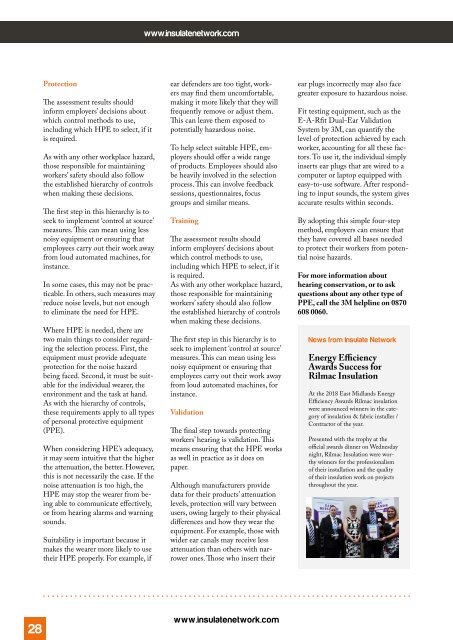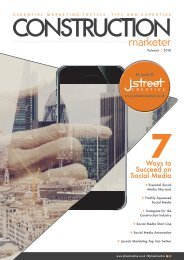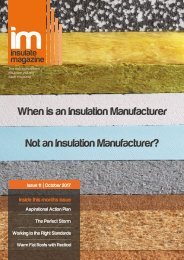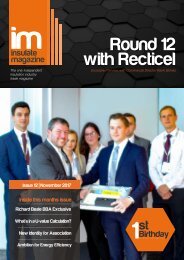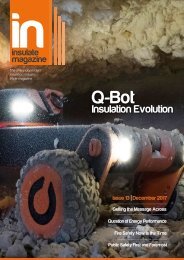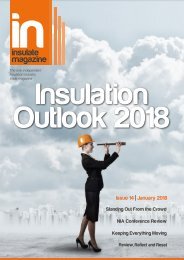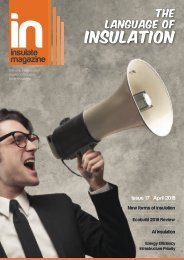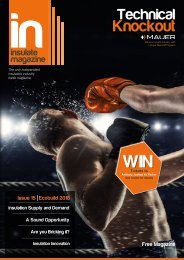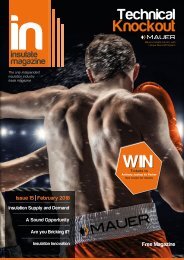Insulate - The Essential Insulation Magazine - May 2018
May Issue of Insulate Insulation Magazine: Exclusive in-depth interview with Isover Insulation's Huw Rees, Schooled in Insulation, Urgent action on Building Safety, Sound Methods of Construction. Also news from Kingspan Insulation, NIA, BUFCA, MIMA, IMA, 3M, Egerton, Baumit, Advanced Insulation, Knauf, Insulation Superstore and many more....
May Issue of Insulate Insulation Magazine: Exclusive in-depth interview with Isover Insulation's Huw Rees, Schooled in Insulation, Urgent action on Building Safety, Sound Methods of Construction. Also news from Kingspan Insulation, NIA, BUFCA, MIMA, IMA, 3M, Egerton, Baumit, Advanced Insulation, Knauf, Insulation Superstore and many more....
Create successful ePaper yourself
Turn your PDF publications into a flip-book with our unique Google optimized e-Paper software.
www.insulatenetwork.com<br />
Protection<br />
<strong>The</strong> assessment results should<br />
inform employers’ decisions about<br />
which control methods to use,<br />
including which HPE to select, if it<br />
is required.<br />
As with any other workplace hazard,<br />
those responsible for maintaining<br />
workers’ safety should also follow<br />
the established hierarchy of controls<br />
when making these decisions.<br />
<strong>The</strong> first step in this hierarchy is to<br />
seek to implement ‘control at source’<br />
measures. This can mean using less<br />
noisy equipment or ensuring that<br />
employees carry out their work away<br />
from loud automated machines, for<br />
instance.<br />
In some cases, this may not be practicable.<br />
In others, such measures may<br />
reduce noise levels, but not enough<br />
to eliminate the need for HPE.<br />
Where HPE is needed, there are<br />
two main things to consider regarding<br />
the selection process. First, the<br />
equipment must provide adequate<br />
protection for the noise hazard<br />
being faced. Second, it must be suitable<br />
for the individual wearer, the<br />
environment and the task at hand.<br />
As with the hierarchy of controls,<br />
these requirements apply to all types<br />
of personal protective equipment<br />
(PPE).<br />
When considering HPE’s adequacy,<br />
it may seem intuitive that the higher<br />
the attenuation, the better. However,<br />
this is not necessarily the case. If the<br />
noise attenuation is too high, the<br />
HPE may stop the wearer from being<br />
able to communicate effectively,<br />
or from hearing alarms and warning<br />
sounds.<br />
Suitability is important because it<br />
makes the wearer more likely to use<br />
their HPE properly. For example, if<br />
ear defenders are too tight, workers<br />
may find them uncomfortable,<br />
making it more likely that they will<br />
frequently remove or adjust them.<br />
This can leave them exposed to<br />
potentially hazardous noise.<br />
To help select suitable HPE, employers<br />
should offer a wide range<br />
of products. Employees should also<br />
be heavily involved in the selection<br />
process. This can involve feedback<br />
sessions, questionnaires, focus<br />
groups and similar means.<br />
Training<br />
<strong>The</strong> assessment results should<br />
inform employers’ decisions about<br />
which control methods to use,<br />
including which HPE to select, if it<br />
is required.<br />
As with any other workplace hazard,<br />
those responsible for maintaining<br />
workers’ safety should also follow<br />
the established hierarchy of controls<br />
when making these decisions.<br />
<strong>The</strong> first step in this hierarchy is to<br />
seek to implement ‘control at source’<br />
measures. This can mean using less<br />
noisy equipment or ensuring that<br />
employees carry out their work away<br />
from loud automated machines, for<br />
instance.<br />
Validation<br />
<strong>The</strong> final step towards protecting<br />
workers’ hearing is validation. This<br />
means ensuring that the HPE works<br />
as well in practice as it does on<br />
paper.<br />
Although manufacturers provide<br />
data for their products’ attenuation<br />
levels, protection will vary between<br />
users, owing largely to their physical<br />
differences and how they wear the<br />
equipment. For example, those with<br />
wider ear canals may receive less<br />
attenuation than others with narrower<br />
ones. Those who insert their<br />
ear plugs incorrectly may also face<br />
greater exposure to hazardous noise.<br />
Fit testing equipment, such as the<br />
E-A-Rfit Dual-Ear Validation<br />
System by 3M, can quantify the<br />
level of protection achieved by each<br />
worker, accounting for all these factors.<br />
To use it, the individual simply<br />
inserts ear plugs that are wired to a<br />
computer or laptop equipped with<br />
easy-to-use software. After responding<br />
to input sounds, the system gives<br />
accurate results within seconds.<br />
By adopting this simple four-step<br />
method, employers can ensure that<br />
they have covered all bases needed<br />
to protect their workers from potential<br />
noise hazards.<br />
For more information about<br />
hearing conservation, or to ask<br />
questions about any other type of<br />
PPE, call the 3M helpline on 0870<br />
608 0060.<br />
News from <strong>Insulate</strong> Network<br />
Energy Efficiency<br />
Awards Success for<br />
Rilmac <strong>Insulation</strong><br />
At the <strong>2018</strong> East Midlands Energy<br />
Efficiency Awards Rilmac insulation<br />
were announced winners in the category<br />
of insulation & fabric installer /<br />
Contractor of the year.<br />
Presented with the trophy at the<br />
official awards dinner on Wednesday<br />
night, Rilmac <strong>Insulation</strong> were worthy<br />
winners for the professionalism<br />
of their installation and the quality<br />
of their insulation work on projects<br />
throughout the year.<br />
28<br />
www.insulatenetwork.com


